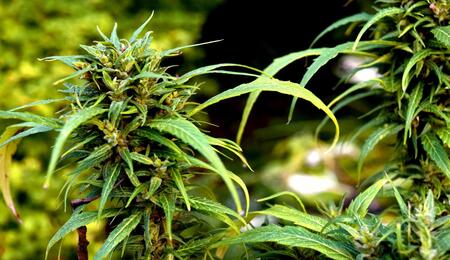How to Grow Marijuana Outdoors: Top Tips and Benefits

If you are curious about growing marijuana on your own, here is a spoiler alert: it’s just like growing tomatoes.
Growing marijuana can be an exciting and rewarding experience, but it comes with its challenges, especially for first-time growers with limited resources. The good news for all the green-fingered smokers out there is that a small outdoor garden can yield a lot of quality cannabis without costing you top dollar. If you have access to a sunny spot in a private backyard, terrace, balcony, or even a rooftop, you are ready to pick up some seeds and give it a go. This short but handy guide to outdoors growing will get into all the factors you need to know before you start.
Benefits of Growing Cannabis Outdoors
Contrary to popular opinion, growing marijuana outdoors is better for both the growers and the plant. There are many benefits in this method that enables the plants to thrive and produce a good harvest.
It’s Cost-effective
The obvious benefit of growing weed outdoors is the free sun. Relying on solar energy is not only a tremendously cost-effective method, but it also has a better effect on the quality of the cannabis plant than the grow lights. The infinite supply of fresh air and rainwater are also free of cost and your future buds will benefit plenty. Supplies that require investment are seeds or clones, soil, fertilizer, and maybe a small greenhouse to get them started. Therefore, as long as you grow cannabis outdoors, your electricity bill doesn’t need to suffer for your attempt to grow your own weed.
Hefty Harvest, Happy Grower
Every veteran budding grower would agree that nothing gives a bigger satisfaction to a weed gardener - except, maybe a good high, than a big, lush marijuana plant. And growing cannabis outdoors leads to pretty huge buds and overall higher yield. Marijuana can grow larger than 70 in (180 cm). With this size, it can potentially produce around 1 pound of dried buds.
It’s Environment Friendly
Indoor growing can be quite wasteful as growing weed inside leads to excessive consumption of energy, because of growing lights, fans and other equipment that eat up a lot of electricity. Outdoors cannabis growing, on the other hand, relies on the sun, air, and water. So, it doesn’t produce any carbon footprint, even contributes to the ecosystem.
It’s a Relaxing and Fun Activity
One should never underestimate the therapeutic effect of gardening. Rolling up your sleeves, and getting your hands dirty, would not only have a relaxing effect on your brain, but you will also learn to appreciate your final product, as there’s nothing better than smoking a weed you grew yourself. Before you start your outdoor operation, there are various important factors you need to consider to ensure success. Below is a list of the essential elements on how to grow a cannabis plant outdoors.
Tips on How to Grow a Cannabis Plant Outdoors
Tip #1 Consider the Climate
While cannabis is adaptable to different conditions, it is also susceptible to extreme weather. Temperature above 86°F (30°C) will cause your cannabis plants to stop growing, while temperature below may cause damage to the plants. High winds and heavy rain can also cause physical harm to plants and excessive humidity can lead to powdery mildew and mould. That being said, it’s important to have a good understanding of the climate in the area you are planning to grow. Consult with local experienced gardeners, as they will have knowledge about dealing with weather conditions when growing flowers and vegetables. You also need to know the length of day throughout the seasons in your area, as knowing the amount of sunlight throughout the year is essential to causing plants to “turn” from the vegetative to the flowering stage.
Tip #2 Choose the Right Space for Your Outdoor Grow
Getting your hands on how to grow a cannabis plant outdoors also means deciding on the space you’ll use for growth. This is one of the crucial parts of the growing process, particularly if you are planting directly in the ground. Your weed should be placed in an optimal spot where it can get as much direct sunlight as possible, during midday, when the light quality is at its finest. As the season changes and fall approaches, the plants will get minimal sunlight throughout the day, which will trigger the flowering stage. A constant breeze works great for your plants, especially in humid areas. If you live in a windy area, consider planting near a windbreak like a fence, or a wall. Finally, you want to consider security and privacy and protect your ‘green Eden’ from judgemental neighbors and potheads with sticky fingers. Large shrubs and tall fences are your best bet unless you live in a remote area. Also, most state laws require growers to keep marijuana plants concealed from the street. Many growers plant in containers on balconies that are shielded from view, and some build heavy-gauge wire cages to keep thieves at bay.
Tip #3 Pick Your Seed
Another important thing you need to do is give some thought to the strain you’d like to plant as you will take care of it for the next few months. Pick a strain that has the features you’re looking for; avoid strains that prefer warm climates if you live in a cold and humid area, or an Indica if you’re looking for a Sativa effect. Remember — the priciest seeds aren’t always the best nor are the cheapest ones the worst. Depending on the legality of marijuana in your state, you may be able to get clones or seedlings from a local dispensary. However, some growers avoid these because they feel they aren’t as sturdy as growing plants from seed. Autoflowering seeds are another popular option for outdoor growing, as they start growing as soon as they reach maturity.
Tip #4 Time to Get Some Soil
You can either buy soil and put it in pots or plant your seed directly in the ground. Cannabis plants thrive in rich and moist soil. If you are planning to grow directly in the ground, you’ll have to understand the composition of the soil and amend it accordingly. Clay soils tend to drain slowly and don’t hold oxygen so they will require a lot of amending. Dig holes where you’ll be placing your plants and mix manure, compost, worm castings, or other decomposed organic matter, at least one month before the planting process begins. Sandy soil, however, is very easy to work with, it drains well and warms quickly, but it doesn’t hold nutrients in rainy environments. If you are working with sandy soil, dig large holes and mix compost and coir which will bind the soil together. The ideal growing medium is silty soil, warms quickly, easy to work with, and holds moisture and has good drainage. Dark crumbly loam is the best silty soil — it’s fertile and it won’t need any amending. To ensure good results and avoid headaches, get your soil tested; it’s easy and inexpensive, and will educate you on the quality of your soil.
Tip #5 Get Some Fertilizer
Cannabis plants require a lot of nutrients over their life cycle, mainly in the form of potassium, phosphorus, and nitrogen. How you feed your puffy beauty will depend on the composition of the soil. You can use commercial fertilizers marketed for home gardeners if you have a good understanding of how they work. First-time growers should avoid these. You can buy nutrient solutions designed uniquely for cannabis, but they are usually expensive and can damage soil bacteria. There are various organic fertilizers available at local garden stores, like fish meal, blood meal, bone meal, bat guano, and kelp meal. So, now you know the essential stuff on how to grow a cannabis plant from start to finish. Of course, you need to watch out for a couple of other things when growing your own weed. For example, you never know if some pests are going to want to infest on your crop, so stay vigilant and ready to deal with any such challenge. Follow and optimize your growing process depending on the needs of your plant. See that your crop is timid on the place where you chose to place it, swap location. See tiny bugs that want to ravage your leaves, get rid of them! Happy growing!



